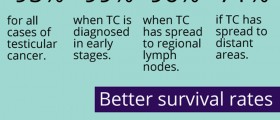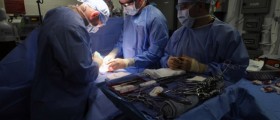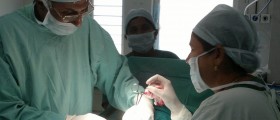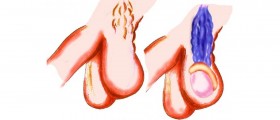Hi
I’m 46 years old and a few years ago while lifting weights, I felt a sharp pain and a feeling of a pull in my testicle. As soon as I stopped, the pain went away but when I looked, my right testicle had moved up and forward. I went for tests and they said I had an inguinal hernia but there wasn’t any pain anymore so I could either leave it or get surgery. Even though my testicle looked weird being up and forward, I decided to leave it for a while but when I started doing more intense exercises involving the abdominal muscles, the pain came back so in the end I decided to get surgery. I just assumed that after surgery, my testicle would return to its normal position but after surgery, it was in the same position (up and forward), there was more pain and my epididymis was enlarged. The doctor prescribed antibiotics for the enlarged epididymis but just told me that he didn’t say that my testicle would go back down if I had surgery and said he didn’t know why it was like that. Since then, I’ve been to 4 different urologists and a couple of GPs and none of them know why my testicle is up and forward which is quite strange because I have found forums online where guys have got the same problem and no urologist can help them or tell them why either. My epididymis is still enlarged (I’ve taken every antibiotic under the sun and nothing helps) and when I sit my testicle is still sore (worse than before the surgery). This has been going on for years now so I’ve just given up and I’m living with the pain and my testicle being up and forward. The only suggestion that one urologist gave was to cut the cremaster muscle but surely there is a more obvious solution because it was perfect before the hernia?
Loading...
Hello. It sounds like you've been through a lot with your condition and the surgeries, and it can be incredibly frustrating to not find clear answers or relief. Here's a general approach to your situation:
-
Anatomical Issue: Your situation sounds like it could be related to an anatomical change due to the hernia or the surgery itself. The position of the testicle being up and forward might be related to the way the inguinal canal was repaired or due to scarring that may have resulted from the surgery.
-
Persistent Epididymitis: If the epididymis remains enlarged and painful despite antibiotics, there could be a few reasons:
- Chronic Infection: The infection may be resistant to the antibiotics you have been prescribed.
- Non-Infectious Causes: The swelling may not be due to an infection but instead due to other issues like autoimmune reactions, trauma, or idiopathic causes.
- Structural Causes: There may be some blockage or structural abnormality that is not being addressed by antibiotics.
-
Cremaster Muscle: Cutting the cremaster muscle is indeed one approach that is sometimes taken to prevent the testicle from retracting. However, this is generally a last resort and not commonly recommended due to the potential for complications and the irreversibility of the procedure.
-
Further Evaluation: You may need a more specialized evaluation, possibly:
- Dynamic Ultrasound: This could assess the blood flow and structure of the testicle and surrounding area both at rest and during maneuvers that provoke your symptoms.
- MRI: In some cases, an MRI can give a more detailed image of soft tissue structures and might provide more information.
-
Pain Management: Consulting a pain management specialist may help you find relief from the chronic pain if a direct treatment for the underlying issue is not found.
-
Physical Therapy: Some patients find relief through pelvic floor physical therapy, which can help manage discomfort and pain related to urological issues.
-
Lifestyle Modifications: Adjusting activities and exercises to avoid those that increase intra-abdominal pressure or strain the area might be necessary to prevent exacerbation of pain.
-
Supportive Undergarments: Wearing supportive undergarments (like a jockstrap) can sometimes help alleviate discomfort by preventing excessive movement of the testicle.
It’s important to keep in mind that without a physical examination and access to your medical history and tests, any advice given here is very general and cannot replace professional medical consultation.
Loading...
















